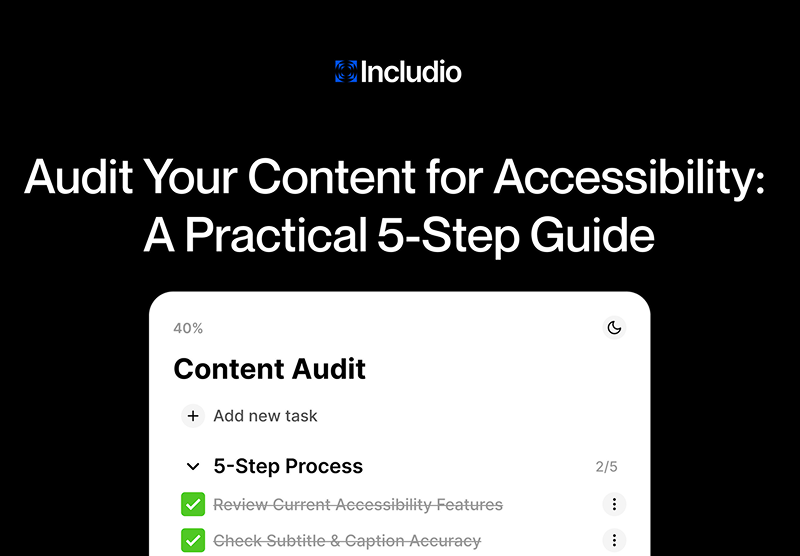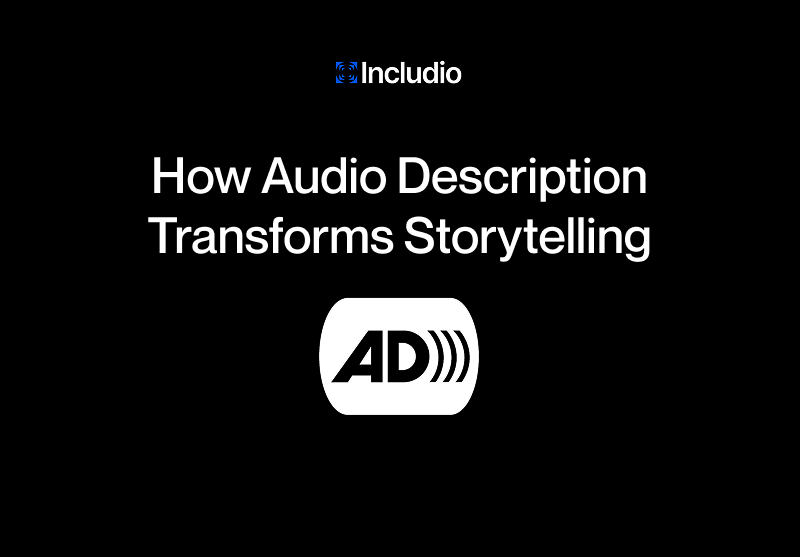
Broadcasters and streaming platforms face growing pressure to make accessibility part of their production DNA. The European Accessibility Act and other global regulations demand inclusive workflows, but many companies are finding that accessibility also improves quality and efficiency. It is now an operational requirement, not an optional feature.
The most forward-thinking broadcasters are building strong accessible media workflow systems that integrate accessibility at every step, from concept and scriptwriting to post-production and delivery. These efforts show how broadcaster accessibility can be built into everyday production, helping teams meet legal standards while enhancing audience experience and creative integrity. Their approach to content production accessibility proves that inclusion and performance can work together in a structured, measurable way.
Why Accessibility Is Now a Production Standard
Accessibility is no longer a technical checkbox. It is a core part of how professional media operates. Viewers expect accessible subtitles, accurate audio description (AD), and multilingual options across all platforms. Broadcasters that fail to deliver these features risk losing audiences and facing compliance penalties.
An effective accessible media workflow does more than satisfy regulators. It improves efficiency and enhances viewer experience. The benefits include:
● Reaching more than 100 million European viewers with accessibility needs.
● Increasing viewer satisfaction through better subtitle and AD quality.
● Building trust with advertisers, regulators, and content partners.
Accessibility has become infrastructure. Broadcasters that invest in strong broadcaster accessibility workflows see measurable returns in audience loyalty and production speed.
Case Study: Transforming a National Broadcaster’s Workflow
A national broadcaster in Europe faced a major challenge. They needed to make more than 60,000 hours of content compliant with 2025 accessibility standards while maintaining broadcast schedules. Their existing system relied on several vendors, inconsistent documentation, and outdated software that made quality control difficult.
To address these problems, we provided a centralized accessible media workflow that combined all accessibility tasks into one managed structure. The new process focused on three major improvements:
- Centralized System: All subtitles, captions, and AD production moved to a single vendor. This consolidation reduced turnaround times by 40 percent, improved visibility, and eliminated duplicate file handling.
- Collaborative Cloud Review: Translation, AD, and editing teams shared real-time dashboards to track tasks, review updates, and document compliance progress. This collaboration ensured accountability and faster approval cycles.
- Integrated Multilingual Delivery: Translation and localization teams worked directly within the same platform. This improved coordination across languages, enhanced content production accessibility, and cut localization delays by 30 percent.
After implementing this model, the broadcaster achieved faster production, better cross-team communication, and stronger compliance tracking. Within one year, costs dropped, audit readiness improved, and accessibility became a standard part of the production pipeline rather than a late-stage correction. Their model is now being studied by other national broadcasters across Europe.
Lessons from Leading Broadcasters
Major broadcasters in Europe, North America, and Asia are building similar systems. Their experiences reveal several shared principles that strengthen broadcaster accessibility performance:
● Plan Accessibility Early: Embed subtitles, captions, and AD in pre-production.
● Standardize Formats: Use common templates for subtitles and audio to simplify collaboration.
● Centralize Oversight: Manage all accessibility content from a single platform.
● Use QA Cycles: Run reviews for timing, translation, and quality before release.
● Balance Automation and Human Review: Combine AI-based transcription with human editing.
These strategies create consistency and accountability across departments while maintaining creative control.
Managing Subtitles and Audio Description in One System
Many production teams still manage subtitles and AD separately. This slows progress and increases costs. Broadcasters that integrate both within one accessible media workflow achieve faster delivery and better quality control. Editors, translators, and describers work from a shared timeline, ensuring every accessibility element matches the narrative tone.
The advantages of integration include:
● Improved alignment between AD and subtitles.
● Shorter turnaround times and fewer revisions.
● Consistent quality across all regional versions.
When broadcaster accessibility teams use integrated tools, they maintain creative integrity while keeping costs predictable.
Balancing Automation and Human Oversight
Automation is now part of every content production accessibility strategy. Modern AI tools can transcribe dialogue, align timecodes, and prepare accurate subtitle drafts within minutes. Human editors then refine the text, ensuring tone, timing, and readability match the production’s creative intent.
This hybrid model boosts efficiency while protecting quality and compliance. It combines technology’s speed with editorial precision, giving production teams full control over accessibility output.
The process typically includes:
● Speech-to-text transcription tools for fast, consistent initial drafts.
● Editors adjusting line breaks, pacing, and clarity for readability.
● Accessibility specialists reviewing AD for narrative flow, timing, and accuracy.
● Final QA passes to verify subtitles and AD against broadcast standards.
When automation and human expertise work together, teams achieve scalable, accurate, and compliant results. This approach allows large broadcasters to manage accessibility across hundreds of hours of content each week without losing quality or creative consistency.
Coordinating Multilingual Accessibility
Global broadcasters manage subtitles and AD across dozens of languages. Multilingual coordination is a major challenge for content production accessibility. The most efficient systems rely on language specialists who understand both translation and accessibility law.
Best practices include:
● Using translation memory systems for recurring phrases and terms.
● Testing each translated subtitle for timing and clarity.
● Applying accessibility guidelines consistently across all markets.
A broadcaster managing 30 regional markets achieved a 35 percent faster turnaround after creating a multilingual accessible media workflow that handled translation, review, and approval in one structure.
Measuring Impact and ROI
An organized broadcaster accessibility pipeline delivers measurable gains. Recent benchmarks show:
● 30 to 40 percent faster delivery of accessible content.
● 25 percent lower production costs from centralization.
● 50 percent fewer compliance errors after process automation.
Accessible workflows also increase audience engagement. Channels offering AD and subtitles see longer viewing times and stronger viewer trust. These numbers demonstrate that accessibility is both good ethics and good business.
How to Build Your Own Accessible Workflow
Building an effective accessible media workflow starts with planning. Follow these steps to develop an integrated process:
- Review your current production process for accessibility gaps.
- Assign clear roles for subtitles, AD, and captions.
- Choose one centralized platform for managing accessibility files.
- Create standardized file templates for consistency.
- Schedule recurring accessibility QA sessions.
- Train your team on accessibility regulations and best practices.
These actions turn content production accessibility into a repeatable and measurable system rather than a last-minute task.
Applying Broadcaster Insights to Other Sectors
The lessons learned from broadcaster accessibility workflows apply across industries. Corporate communications, e-learning, and marketing teams all benefit from organized accessibility pipelines. Early planning, centralized review, and cross-team coordination lower costs and improve reach.
An accessible workflow guarantees every viewer can engage with your message. It also proves accountability and care, two factors that strengthen brand reputation and regulatory confidence.
Next Steps: How Includio Supports Enterprise Accessibility Pipelines
See how Includio supports enterprise accessibility pipelines. Our technology and accessibility network help broadcasters and media teams manage subtitles, captions, AD, and multilingual delivery through a centralized accessible media workflow. This structure strengthens compliance, efficiency, and quality across every stage of content production accessibility.




